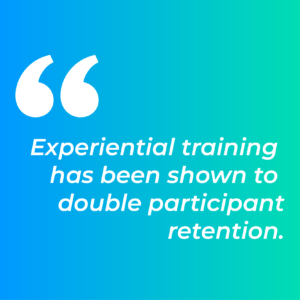What’s your HR digital strategy? Does it include advanced training technology like augmented and virtual reality? Should it?
Augmented reality (AR) uses computer-generated images superimposed over real-world objects or spaces. In virtual reality (VR), the entire environment and experience are computer-generated. Both are well-suited to many different skills management training scenarios.
Benefits of Utilizing AR and VR for Employee Training
AR and VR training is immersive and experiential.
People learn by doing. Pilots can now train in virtual cockpits that look, sound and feel like the real thing. They can practice “flying” new planes and practice different scenarios without ever leaving the ground.
Virtualization enables otherwise impossible training scenarios.
Consider healthcare as an example. Medical schools can create a virtual operating room with a virtual patient. The Cleveland Clinic teaches cardiothoracic surgery using virtual patients, avoiding complicated ethics and safety concerns.
Utilizing AR and VR technology can lower your training and other costs.
An oil and gas company can create a replica of any rig and provide “offshore” training without transportation costs. The same virtual asset can be used to train a maintenance worker before he heads offshore. This virtualized training helps improve first-time fix rates, saves transportation costs, and decreases equipment downtime.
Why AR/VR Technology Implementation Requires Skills Management
Is Your Workforce Ready for Virtualization?
Virtualized training is one example of technology that requires specialized skills. You need the right people with the right skills to manage the technology. Do your instructors know how to create virtualized training? Can HR identify upskilling and reskilling opportunities for smart workforce planning?
Skills management is the only way to answer these questions.
Use Skills Management to Design Your Virtual Training
Workers have different skill levels and gaps. Using a digital skills platform allows you to construct custom training. Let’s consider two manufacturing employees who work on the same piece of equipment. They both need to be trained to measure their level of skills and close any gaps. With one virtual asset, you can create scenarios to train any employee based on their current skills. With this approach, employees only spend time on the training they need.
Skills Management Adds Valuable Context Within Virtual Training
Expanding on the manufacturing example, maybe you have a tenured employee who needs training on a new piece of equipment. Do you know which existing skills are applicable? When you integrate a skills catalog with virtual training, the employee can see how their current skills apply to the new equipment. Maybe they know the high-pressure valve but not the digital display. The virtualized training can be augmented to help employees identify where to spend their valuable training time.
With a Digital Skills Platform, AR/VR Simulations Can Become the Assessment
Once virtualized training is in place, it can be extended to provide skills information to the employee, HR, and management. Going back to our manufacturing employees, they can view what skills they have acquired, mastery levels, and the assessments they may want to tackle next.
That same intelligence can be used to update the skills catalog and inform the employee’s next assessment test. Managers won’t need to test the employee’s competence after training; the training is the test.
Is your company considering AR or VR technology? We can help get your workforce ready for the digital transformation with skills management. Get in touch.






